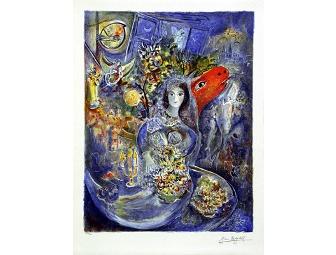Art
Marc Chagall Color Lithograph: "Bella"
- Item Number
- 140
Item Description
This is a beautiful limited edition (edition size 2000) print from renowed painter "Marc Chagall." It is 35" x 24".
Item Special Note
Marc Chagall Bio
Marc Chagall, the eldest of nine children, was born as Moyshe Segal in July 1887 in the Russian city of Vitebsk. His mother wanted him to be a clerk/accountant, but he saw his way out through enrollment at Yehuda Pen’s School of Painting and Design.
In 1905 he moved to St. Petersburg where he met Max Vinaver, one of the first Jewish deputies of the Duma (Parliament) who was impressed by Chagall’s work. Chagall entered the Zvantseva School where he was taught by Leon Bakst, one of the leaders of the Symbolist art movement. In 1910 he moved to Paris and by 1912 he moved to “La Rouche” where, according to Chagall, “the artistic bohemia of every land lived.” He was greatly influenced by Van Gogh, El Greco, Gauguin and Goya. During this time he struck up a friendship with Apollinaire and Chagall rejected the austerity of cubism in favor of a more lyrical art on the principles of color theory (Orphism). Like the French Fauvres who used color without inhibition, Chagall moved toward an expressionist art using “primitive” distortion, simplified line, and large areas of bold unbroken color.
He was also greatly influenced by his upbringing. Chagall once described “the mystique of Hasidism” as one of the fundamental sources of his art. According to Erich Neumann, “The warm, earthly fervor of Hasidic mysticism - a universe where logic was overturned by magic and metamorphosis, where reality became myth.” In this fusion of motifs taken from Jewish and Russian folk art, he began to develop an original language of symbols - his “Chagallian” universe: Floating lovers, a fiddler on the roof, flying horses, “blue air, love and flowers”.
In 1915 he married Bella and until her death of a viral infection in 1944, she remained Chagall’s constant companion and inspiration.
In 1917, the October Revolution brought the emancipation of the Jews in Russia. Until 1920, when Chagall left Vitebsk for good, he moved to Moscow with Bella and their daughter Ida (born in 1916). There he devoted his life to running his Academy of Art. As conditions continued to deteriorate, he left Russia for Berlin with a collection of paintings and the nine notebooks containing the manuscript copy of his life.
By September of that year, Chagall was back in Paris, and for the next few years he worked tirelessly to produce a series of etchings for Gogol’s Dead Souls for Ambrose Vollard. Other commissions followed: the seventeenth century French classic, Fables of La Fontaine, Cirque and The Bible Series. By 1927, Chagall was one of the leading painters of Ecole de Paris, and his work was exhibited around the world.
NJ LEEP, inc. stores data...
Your support matters, so NJ LEEP, inc. would like to use your information to keep in touch about things that may matter to you. If you choose to hear from NJ LEEP, inc., we may contact you in the future about our ongoing efforts.
Your privacy is important to us, so NJ LEEP, inc. will keep your personal data secure and NJ LEEP, inc. will not use it for marketing communications which you have not agreed to receive. At any time, you may withdraw consent by emailing Privacy@frontstream.com or by contacting our Privacy Officer. Please see our Privacy Policy found here PrivacyPolicy.

